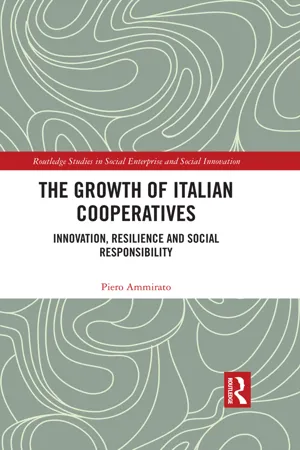
The Growth of Italian Cooperatives
Innovation, Resilience and Social Responsibility
- 224 pages
- English
- ePUB (mobile friendly)
- Available on iOS & Android
About This Book
The Italian Cooperative Sector is amongst the largest in the world comprising over 60, 000 cooperatives from all sectors of the economy directly employing 1.3 million people. Cooperatives created close to 30 percent of new jobs in Italy between 2001 and 2011 demonstrating that democratic cooperative enterprises can successfully operate in a market economy combining economic success and social responsibility. These offer a viable alternative to profit maximising enterprises and an opportunity to create a more pluralist and democratic market economy.
The Growth of Italian Cooperatives: Innovation, Resilience and Social Responsibility comprehensively explains how the Italian cooperative sector has managed to compete successfully in the global economy and to grow during the global financial crisis. This book will comprehensively explain how the Italian cooperative movement has managed to grow into a large successful network of cooperatives. It will examine the legislative framework and their unique business model that allows it to compete in the market as part of a network that includes central cooperative associations, financial and economic consortia, and financial companies. It will explore cooperative entrepreneurship through a discussion of the formation of cooperative groups, start-ups, worker-buyouts and the promotion of entirely new sectors such as the social services sector. Finally, The Growth of Italian Cooperatives examines how cooperatives have managed the GFC and how their behavior differs from private enterprises. It will also analyze the extent to which cooperatives compete while still uphold the key cooperative principles and fulfil their social responsibility.
This book is an interdisciplinary study of cooperative development and is designed to inform members of the academic community, government, public policy makers and cooperative managers that are primarily interested in economic democracy, economics of the cooperative enterprise, cooperative networks and economic development, cooperative legislation, democratic governance, job creation programs, politics of inclusion and how wealth can be more equitably distributed.
Frequently asked questions
1
Introduction
- Cooperatives are present throughout Italy, including in the North-East, providing 30.7 percent of the total cooperative workforce; the North-West, 27.9 percent; the Center, 19.4 percent; and the South, 22 percent (Fondazione Censis 2012).
- Cooperatives operate in all sectors of the economy, including banking and insurance, agriculture, retail, manufacturing and construction, maintenance, cleaning, catering, social services, medical services, tourism, culture and entertainment.
- They hold a substantial market share in some sectors: more than 50 percent in social services; 33 percent in the retail sector; 33 percent in insurance; 25 percent in agri-business (V. Zamagni 2017); 10.7 percent in construction and housing; 9.5 percent in the service industry (Borzaga 2015); and representing 9 percent of the total business loans and 8.5 percent of the total family loans (Federcasse 2016).
- The percentage of employment share is high in the following sectors: social services cooperatives employ 44.5 percent of total private sector employment; transport employs 20 percent; agri-business employs 13.2 percent; general services industry employs 11.6 percent; the construction business employs 6.1 percent; and the retail sector employs 4.3 percent (Borzaga 2015).
- Cooperatives are, on the whole, larger than the average Italian enterprise. While cooperatives make up only 1.5 percent of the total firms operating in Italy, they represent 17.3 percent of all medium-sized enterprises with a workforce between 50 and 250 employees and 14.8 percent of all large enterprises with a workforce of more than 250 employees (Alleanza delle Cooperative Italiane 2017). In addition, there are 250 cooperatives and consortia across Italy with turnovers of more than 50 million euros. They are market leaders in retail, insurance, agriculture, construction, manufacturing, general maintenance and social services (Alleanza delle Cooperative Italiane 2016).
- Are cooperatives able to achieve economic performance in compliance with the law and in alignment with international cooperative principles?
- How has the cooperative business network model managed to overcome key obstacles to cooperative development such as access to finance, management expertise and democratic governance?
- Can cooperatives grow into large market players and form cooperative groups of companies without degenerating or demutualizing?
- Are cooperatives and their networks better suited than capitalist enterprises to managing an economic crisis, and what do the different approaches tell us about cooperative behavior as compared to that of a capitalist enterprise?
- To what extent has cooperative identity evolved, and what are the challenges associated with these changes?
- Does the current size, inter-sectoral diversity, multiple enterprise model and the network capability of the cooperative sector place it in a position to further expand economic democracy in a pluralist market economy?
1.1 Why Is This Study Important?
1.2 The International Cooperative Alliance: Principles, Cooperative Typology and Size
1.2.1 Cooperative Principles
- A cooperative is defined as an autonomous association of persons united voluntarily to meet their common economic, social, and cultural needs and aspirations through a jointly-owned and democrati...
Table of contents
- Cover
- Title
- Copyright
- Contents
- List of Tables and Figure
- Acknowledgments
- List of Abbreviations
- 1 Introduction
- 2 The Legislative Framework: Enabling Growth and Promoting Cooperative Principles
- 3 Central Associations: Leadership and Economic Development
- 4 Financing Cooperatives: Members, Markets and Networks
- 5 Consortia Network: Economies of Scale and National Expansion
- 6 The Rise of Cooperative Groups: A New Cooperative Model?
- 7 Entrepreneurship: Start-Ups, Worker-Buyouts and Social Cooperatives
- 8 Cooperative Resilience: Managing the Global Financial Crisis
- 9 Principles and Social Responsibility: People and Communities Before Profits
- 10 Cooperative Identity: In Search of a New Vision
- 11 Conclusion: Toward a More Pluralist and Democratic Market Economy
- Index